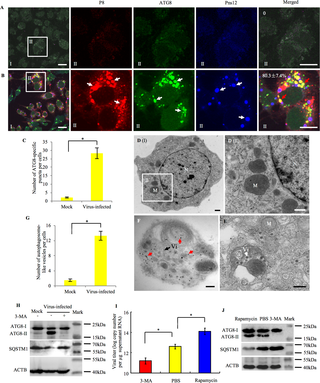PLoS Pathogens ( IF 6.7 ) Pub Date : 2017-11-10 , DOI: 10.1371/journal.ppat.1006727 Yong Chen , Qian Chen , Manman Li , Qianzhuo Mao , Hongyan Chen , Wei Wu , Dongsheng Jia , Taiyun Wei

|
Many viral pathogens are persistently transmitted by insect vectors and cause agricultural or health problems. Generally, an insect vector can use autophagy as an intrinsic antiviral defense mechanism against viral infection. Whether viruses can evolve to exploit autophagy to promote their transmission by insect vectors is still unknown. Here, we show that the autophagic process is triggered by the persistent replication of a plant reovirus, rice gall dwarf virus (RGDV) in cultured leafhopper vector cells and in intact insects, as demonstrated by the appearance of obvious virus-containing double-membrane autophagosomes, conversion of ATG8-I to ATG8-II and increased level of autophagic flux. Such virus-containing autophagosomes seem able to mediate nonlytic viral release from cultured cells or facilitate viral spread in the leafhopper intestine. Applying the autophagy inhibitor 3-methyladenine or silencing the expression of Atg5 significantly decrease viral spread in vitro and in vivo, whereas applying the autophagy inducer rapamycin or silencing the expression of Torc1 facilitate such viral spread. Furthermore, we find that activation of autophagy facilitates efficient viral transmission, whereas inhibiting autophagy blocks viral transmission by its insect vector. Together, these results indicate a plant virus can induce the formation of autophagosomes for carrying virions, thus facilitating viral spread and transmission by its insect vector. We believe that such a role for virus-induced autophagy is common for vector-borne persistent viruses during their transmission by insect vectors.
中文翻译:

植物病毒诱导的自噬途径通过其昆虫载体促进病毒传播和传播
许多病毒病原体是通过昆虫媒介持续传播的,并引起农业或健康问题。通常,昆虫载体可以使用自噬作为抵抗病毒感染的内在抗病毒防御机制。病毒是否可以进化以利用自噬促进昆虫媒介传播。在这里,我们显示自噬过程是由植物呼肠孤病毒,稻胆矮病毒(RGDV)在培养的叶蝉载体细胞和完整昆虫中的持续复制触发的,这由明显的含病毒的双膜自噬体的出现证明。 ,将ATG8-I转换为ATG8-II并增加自噬通量水平。这种含病毒的自噬体似乎能够介导培养细胞的非溶解性病毒释放或促进病毒在叶蝉肠道中传播。Atg5显着降低体外和体内的病毒传播,而应用自噬诱导剂雷帕霉素或沉默Torc1的表达有助于这种病毒传播。此外,我们发现自噬的激活促进了有效的病毒传播,而抑制自噬则通过其昆虫载体阻止了病毒的传播。总之,这些结果表明植物病毒可以诱导自噬体的形成以携带病毒体,从而通过其昆虫载体促进病毒的传播和传播。我们相信,这种病毒诱导的自噬作用在昆虫传播媒介的过程中对于媒介传播的持久性病毒是很普遍的。



























 京公网安备 11010802027423号
京公网安备 11010802027423号